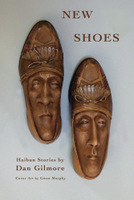|
KYSO Flash ™
Knock-Your-Socks-Off Art and Literature
|
|
|||
[Redemption Is Found in the Oddest Places]by Kathryn KulpaA haibun is a short prose work—flash fiction, prose poetry, memoir, travel narrative—combined with a haiku or senryu, a brief lineated poem that illuminates the prose in some way. The relationship of the haiku to the story is not simplistic, as in a moral or summary. It could be seen as the equivalent of a musical counterpoint, offering a variation on a theme. The haiku, often coming at the conclusion of the prose piece, may send us back to the story with a new perspective or make us think about it in a different way. When online lit journal KYSO Flash posted a call for haibun stories, award-winning poet and fiction writer Dan Gilmore responded with multiple stories and soon had enough for a chapbook, and then a full-length collection. Some of the pieces in New Shoes have been published previously in KYSO Flash or other journals or in collections, while others are published for the first time. The theme and mood of the pieces vary from philosophical to gently humorous, from quirky slices of life to bittersweet meditations on aging and mortality. In “Lazarus Ponders His Resurrection,” the reanimated Lazarus wonders why that nice young man who brought him back didn’t take care of his bad teeth while he was at it. Like many of Gilmore’s haibun, “Lazarus” walks a fine line between faith and doubt, between ordinary human kvetching and a zen acceptance of life’s ironies. Despite dark moments, they are never without hope. Redemption, in these stories, is found in the oddest places. “Hackmuth’s Mannequin Dream” shows us a lonely man who falls in love with a department store mannequin; “Wheels: A Love Poem” follows the narrator’s dating history through a series of cars. In “Dark Angel,” a doubt-wracked nun finds the presence of God in a cockroach, while the beleaguered high school teacher of “Sam Snyder’s Puzzlement” is genuinely surprised at the sometimes stellar fates and the gratitude of his “nose-picking, giggling, zit-squeezing” students. “Raymond’s Epiphany,” a gem of dark, understated humor, tells the story of a laboratory research assistant who finds unlikely romantic inspiration in the mating behavior of Mr. Big, an overweight, brain-damaged rodent. This tale is punctuated with a haiku and ends with a tanka, a five-line poem, making it an unusual melding of forms that is also genuinely funny. The prose pieces in New Shoes show the range possible in flash fiction, from telegraphic prose poems to short stories in miniature. “Summer Night-Sounds of Tucson,” for example, is a lush, sensory rendering of place and time, with “broken-throated songs of great love” drifting in and out of Mexican radio stations while coyotes crouch, always hungry, always waiting. “Overheard in Silverman’s Deli, St. Paul, Minnesota” is a complete narrative told only through dialogue, while “Making a Deal with God” takes the form of a dramatic monologue. Most of the pieces, though, strike a balance somewhere between image and narrative, juxtaposing sharply observed moments of temporal life with the more philosophical, interior musings of the haiku. “We play with the dogs we’re dealt,” Gilmore concludes his haibun “The Radiance,” about a near-death experience involving a tiny dog wearing a sombrero. This unique blend of the spiritual and the absurd—the sublime and the ridiculous, or the ridiculousness that is sublime—defines Gilmore’s work, as nearly as any definition can. These small, precisely crafted stories are a good introduction to haibun for those unfamiliar with the form and a boon for those who already know and appreciate these hybrid works.
—First published on 1 October 2016 at the KYSO Flash Facebook page; appears here by author’s permission Kathryn KulpaIssue 7, Spring 2017
was a winner of the Vella Chapbook Contest for her flash fiction chapbook Girls on Film (Paper Nautilus Press, 2016). She is flash fiction editor at Cleaver Magazine and has published work in Monkeybicycle, Angels Flight: Literary West, and SmokeLong Quarterly. [For an expanded list, please visit the author’s website, http://www.kathrynkulpa.com/.] More on the Web: By, About, and Beyond⚡ A Conversation with Kathryn Kulpa by Michelle Fost in Cleaver Magazine |
|
Site contains text, proprietary computer code, |
|
| ⚡ Many thanks for taking time to report broken links to: KYSOWebmaster [at] gmail [dot] com ⚡ | |
